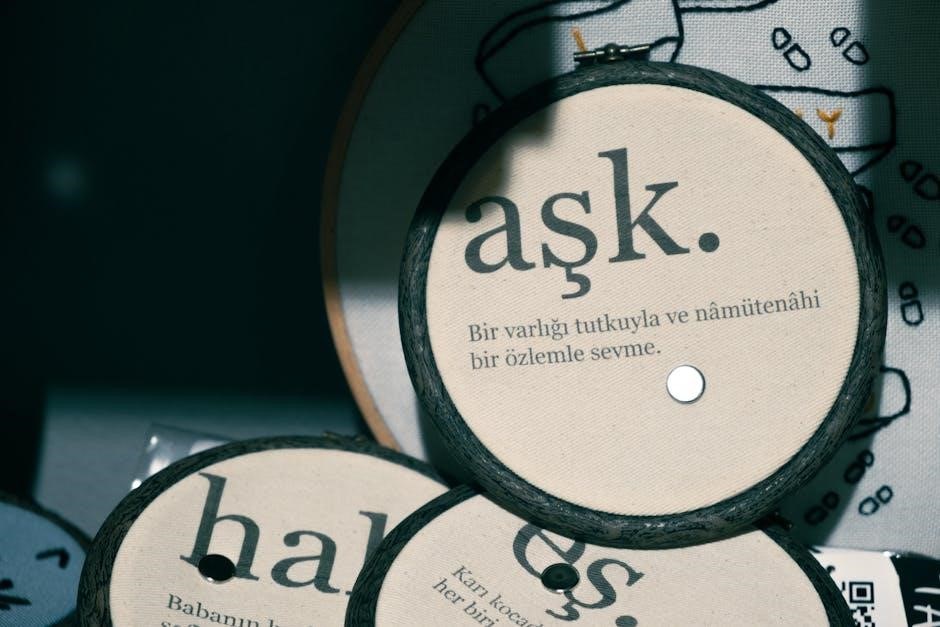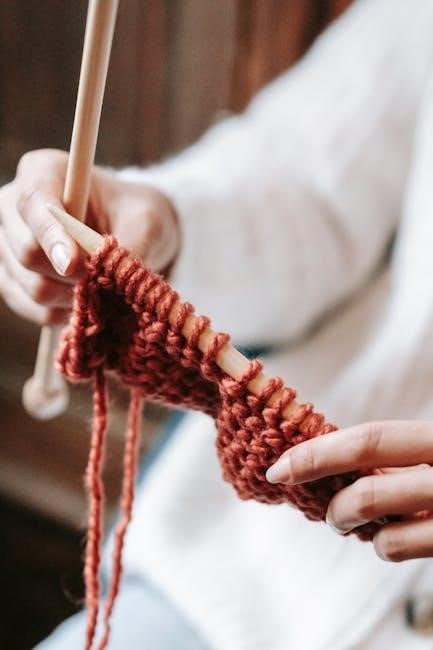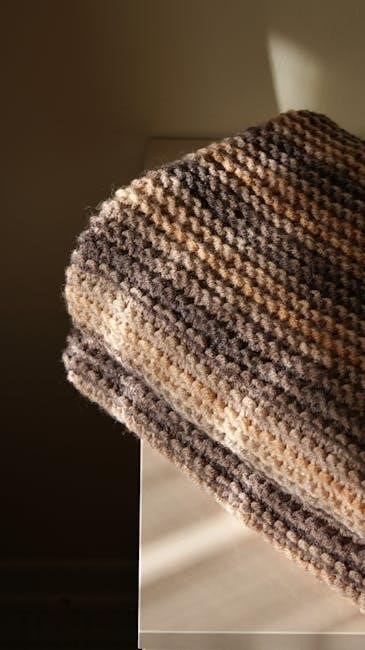Tunisian crochet, sometimes known as Afghan crochet, is a unique technique blending knitting and crochet. This method uses an elongated hook, creating a dense fabric. It’s a versatile craft, allowing diverse textures and patterns.
What is Tunisian Crochet?
Tunisian crochet is a fascinating hybrid of knitting and crochet. It uniquely uses a longer hook, often called an Afghan hook. The process involves drawing loops onto the hook during the forward pass, then working them off in the return pass. This creates a fabric that’s denser and less flexible than traditional crochet.
Unlike standard crochet, Tunisian crochet keeps all loops on the hook at once, resembling knitting in that aspect. This allows for the creation of wider pieces without seaming. Tunisian crochet offers a vast array of stitch patterns, from basic to intricate, enabling diverse textures and designs. It’s an excellent craft for blankets, scarves, and home decor.
Exploring Tunisian crochet opens up a world of creative possibilities. Its distinct texture and structure set it apart, making it a rewarding skill to learn and master. Whether you’re a seasoned crocheter or a curious beginner, Tunisian crochet offers a fresh perspective on yarn crafts.

Basic Tunisian Crochet Stitches
Mastering basic stitches is crucial for Tunisian crochet. These form the foundation for more complex patterns. The Tunisian Simple Stitch and Knit Stitch are excellent starting points for beginners.
Tunisian Simple Stitch (Tss)
The Tunisian Simple Stitch (Tss) is the most fundamental stitch in Tunisian crochet, and it’s often the first one learned by beginners. It creates a dense, woven-like fabric that’s perfect for a variety of projects. To work a Tss, you’ll first need to complete a foundation row.
To begin, insert your hook from right to left into the second vertical bar of the foundation row. Yarn over and pull up a loop, keeping the loop on your hook. Repeat this process across the entire row, inserting your hook into each vertical bar and pulling up a loop.
Once you reach the end of the row, you will have a series of loops on your hook. This completes the forward pass. The return pass is then worked to complete the stitch. The Tss creates a solid fabric with a distinctive vertical texture.
Tunisian Knit Stitch (Tks)
The Tunisian Knit Stitch (Tks) mimics the look of knitted fabric, providing a different texture compared to the Tunisian Simple Stitch. This stitch creates a more elastic and flexible fabric, making it suitable for garments and items needing drape. To execute the Tks, start with a foundation row.
Instead of inserting your hook into the vertical bar as in the Tss, you’ll insert it behind the vertical bar, from front to back, mimicking a knit stitch. Yarn over and pull up a loop, keeping the loop on your hook. Repeat this step across the row, inserting your hook behind each vertical bar.
As with the Tss, once you reach the end of the row, you’ll have a series of loops on your hook, completing the forward pass. Then, work the return pass as usual to complete the stitch. The Tks produces a fabric with a distinct “V” shape, similar to the knit stitch.

Advanced Tunisian Crochet Stitches
Beyond basic stitches, Tunisian crochet offers complex patterns. These advanced techniques involve combining stitches or manipulating rows. Mastering these opens doors to intricate designs and textures, expanding creative possibilities.
Tunisian Ripple Stitch
The Tunisian Ripple Stitch creates a beautiful, undulating texture, perfect for afghans and scarves. This stitch uses increases and decreases strategically placed across the row to form the characteristic wave pattern. The ripple effect can be subtle or dramatic, depending on the frequency and size of the increases and decreases.
To achieve this stitch, you’ll typically work a combination of Tunisian Simple Stitches (Tss) and elongated stitches. Understanding the placement of these stitches is key to creating a consistent ripple. Many patterns use a combination of front loop and back loop stitches to add further definition to the waves.
Experimenting with different yarn weights and hook sizes can also alter the appearance of the ripple. The Tunisian Ripple Stitch offers endless variations, making it a rewarding technique for adding visual interest to your projects. It’s a popular choice for creating cozy and eye-catching designs.
Short Rows in Tunisian Crochet
Short rows in Tunisian crochet are a technique used to create shaping and curves within a project. Unlike regular rows that span the entire width of the fabric, short rows are worked only partially, leaving some stitches unworked at the end of the row. This allows you to add height or width to specific areas, creating angles, curves, and three-dimensional effects.
To work short rows, you’ll stop before reaching the end of the forward pass, then work a return pass as usual. On the subsequent row, you’ll work to the turning point created by the previous short row. This creates a gradual increase or decrease in the fabric.
Short rows are excellent for shaping shoulders, creating fitted garments, and adding unique design elements to your Tunisian crochet projects. Mastering this technique opens up a world of possibilities for creating intricate and customized designs. Understanding how to execute short rows is crucial for advanced Tunisian crochet work.

Free Tunisian Crochet Patterns & Resources
Explore a world of free Tunisian crochet patterns and resources to enhance your skills. Discover beginner-friendly projects and stitch collections to ignite your creativity and master this versatile craft.
Beginner-Friendly Patterns (PDF Downloads)
Embark on your Tunisian crochet journey with our curated selection of beginner-friendly patterns available as convenient PDF downloads. These patterns are designed to introduce you to the fundamental Tunisian crochet stitches and techniques, ensuring a smooth and enjoyable learning experience.
Each PDF includes clear, step-by-step instructions, accompanied by helpful diagrams and photographs, guiding you through every stage of the project. Discover patterns for simple scarves, cozy blankets, and stylish accessories, perfect for practicing your newfound skills.
These beginner-friendly patterns utilize basic stitches like the Tunisian Simple Stitch (Tss) and Tunisian Knit Stitch (Tks), allowing you to build confidence and develop a solid foundation in Tunisian crochet. Download your free PDF patterns today and start creating beautiful, textured projects with ease!
Tunisian Stitch Collections and Tutorials
Expand your Tunisian crochet repertoire with our extensive collection of stitch tutorials and patterns. Delve into a world of textures and designs, mastering a variety of unique stitches that will elevate your projects. Our tutorials provide in-depth instructions, accompanied by clear visuals, making even complex stitches accessible to all skill levels.
Explore stitch patterns like the Tunisian Honeycomb Stitch, Tunisian Smock Stitch, and Tunisian Full Stitch, each offering a distinctive look and feel. Learn how to combine these stitches to create intricate patterns and stunning visual effects.
Access our curated collections of Tunisian stitch patterns, perfect for blankets, scarves, garments, and home decor items. Whether you’re a beginner or an experienced crocheter, our resources will inspire you to experiment and unlock the full potential of Tunisian crochet. Discover new techniques and create beautiful, textured masterpieces.

Tips and Tricks for Tunisian Crochet
Master Tunisian crochet with these essential tips and tricks. Learn how to prevent curling, choose the right hook, and manage yarn tension. Perfect your technique and create flawless projects every time.
Yarn and Hook Selection
Selecting the right yarn and hook is crucial for successful Tunisian crochet. The yarn’s weight influences the fabric’s drape and texture; experiment with different fibers to achieve varied effects. For beginners, smooth, light-colored yarns are recommended for visibility. Consider cotton or acrylic for practice, then explore wool blends.
Hook selection depends on yarn weight and project size. Tunisian crochet requires longer hooks to accommodate loops. Standard crochet hooks are inadequate. Choose a hook size appropriate for the yarn to prevent overly tight or loose stitches. Bamboo or ergonomic hooks enhance comfort, especially during extended projects.
When starting, use a hook one or two sizes larger than suggested for the yarn. This helps maintain even tension and prevents the project from curling excessively, a common issue in Tunisian crochet. Consistent gauge is important, so swatch with your chosen yarn and hook.
Seaming and Finishing Techniques
Effective seaming and finishing are vital for professional-looking Tunisian crochet projects. Seaming joins individual pieces seamlessly, while finishing techniques add polish. The mattress stitch is excellent for invisible seams, creating a flat, cohesive join. Alternatively, slip stitch or single crochet seams offer decorative options.
For edges, consider a simple single crochet border to prevent curling and provide a clean finish. Blocking is essential to shape and even out the fabric; wet blocking works well for natural fibers, while steam blocking suits synthetics. Weaving in loose ends meticulously ensures durability and neatness.
Experiment with different edging techniques, such as picot or reverse single crochet, for added flair. Adding fringe or tassels complements the design. Proper finishing elevates the final product, highlighting the beauty of Tunisian crochet stitches and enhancing the overall quality and appearance.